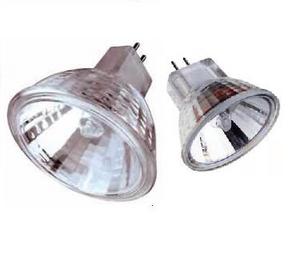Questions about lamps:
|
|
What is a halogen burner or capsule?
A.
The 'MR' stands for Multifaceted Reflector. this is a pressed glass reflector with the inside (reflecting side) surface composed of facets and covered by a reflective coating. These facets provide optical control by gathering the light from the filament to create a concentrated beam of light. The reflectors of some MR lamps have a smooth inside surface instead of facets, but they are still called MR lamps.The reflective coating of MR16 lamps can be either dichroic or aluminium. A dichroic coating is a thin, multi-layer dielectric (non-metallic film) that allows infrared radiation (heat) from the filament capsule to pass through the reflector while it reflects visible radiation (light) forward. An aluminium coating is a thin film of aluminium that, unlike the dichroic coating, reflects both infrared and visible radiation.
Some MR16 lamps are described as closed or open. The closed lamps have a cover glass on the front end of the reflector. This cover is a safety measure designed to contain any broken fragments in case the lamp shatters when it fails. The open do not have this cover.
MR lamps come in different sizes. The most common MR16, is 16 eighths of an inch (5 centimeters) in diameter at its largest circumference, hence the name "MR16." MR11 (1-3/8 inch, or 3.5 centimeters, diameter).
The power ratings of MR16 lamps used in architectural lighting applications range from 10 to 100 watts. Most MR16 lamps are operated using voltages lower than 120 volts, typically 12 volts. Therefore a transformer is needed to reduce the line voltage to the appropriate level for these lamps.
- The light source of MR lamps is a single-ended quartz halogen filament capsule.
- Type of light – a bright, clear, directional light.
- The beam size 7 to 60 degrees
- Lifespan – 2000 and 10,000 hours
- Colour temperature – 2,800/3,200 degrees Kelvin
Advantages
- More energy efficient as the bulb wattage’s tend to be lower, which makes them cheaper to run.
- Produce the same amount of light as an ordinary tungsten bulb at a lower wattage.
- Provide an instant controllable light
- Available in a wide range of shapes, sizes, beam spread, colours, fittings and wattage
- Dimmable with a dimmable transformer
Disadvantages
- Require a transformer to convert 240V to 12V.
- Transformers may either be within the fitting itself or connected to the circuit.
- Touching the bulb’s glass will shorten its life.
- Will generate a lot of heat
Q. What is a halogen burner or capsule? 
A. The filament of a low voltage halogen lamp burns at a higher temperature than in a standard tungsten lamp and uses a higher gas pressure. This means that the lamps can be smaller and made from quartz in order to withstand the greater heat.
- Type of light - a cool, crisp, white light. Of all domestic light sources, they produce a light closest to natural daylight.
- Voltage – 12V
- Lifespan – 3,000 to 5,000 hours
- Colour temperature – 3,000 degrees Kelvin
Advantages
- More energy efficient as the bulb wattage’s tend to be lower, which makes them cheaper to run.
- Produce the same amount of light as an ordinary tungsten bulb at a lower wattage.
- Provide an instant controllable light .
- Available in a wide range of shapes, sizes, beam spread, colours, fittings and wattage.
- Dimmable with a dimmable transformer.
Disadvantages
- Require a transformer to convert 240V to 12V. Transformers may either be within the fitting itself or connected to the circuit.
- Touching the bulb’s glass will shorten its life.
- Will generate a lot of heat
A. LED stands for Light Emitting Diode
LED have been around for many years. They have been used in electrical equipement as indicators. In recent years clever people have made the low energy using components brighter and they continue to get bright. As a light source it is now comparable to an incandescent, is more efficient than a fluorescent and has the longest life span of any light source.
- Type of light – a bright, clear, directional light.
- The beam size depends on the number of LED put together.
- Lifespan – 50,000 hours
- Colour temperature – 2,000/3,000 degrees Kelvin
Advantages
- Long life span
- Very cost effective, low voltage and low energy consumption
- Low operating temperature
- Available in a wide range of colours
Disadvantages
- Not good for projecting light a long distance
- Cannot be regularly dimmed, they require electronic circuitry built into the product.


